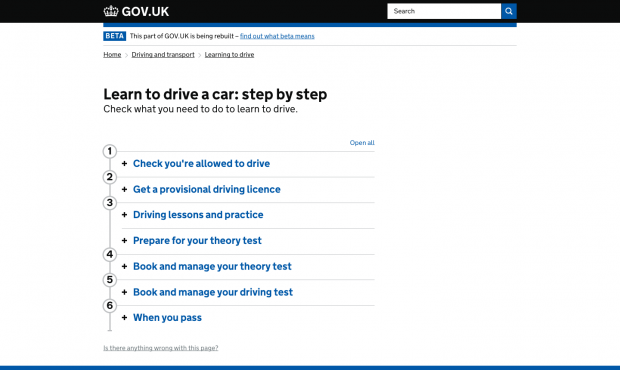As Head of User-Centered Design and Service Standards at the Government Digital Service (GDS) and across government, it’s my role to support government to design and build user-centred services.
At GDS we’re working hard to give people across government the tools and resources they need to do this. We’re doing the hard work to make service design simple for all of government.
Here are 6 of the things we’ll be working on this year that will help departments to design better services across government:
1. Building GOV.UK Design System

GOV.UK Design System will contain all the styles, components and design patterns that teams in government need to create user-centred digital services.
Some of these things can already be found in the Service Manual, GOV.UK Elements and elsewhere, but we want to bring everything together in one place and make it easy for people to find, use and contribute to.
GOV.UK Design System is currently in private beta, and we’re working with teams across government to test and develop it before we roll it out more widely. In the meantime, you should continue to use the design patterns, components and styles found in the Service Manual and GOV.UK Elements.
2. Updating the Service Standard

Since it was first launched, the Digital Service Standard has helped government build user-focused digital touchpoints. Now we want to update the standard so that it supports end-to-end services across government. Services as users understand them. Such as learning to drive, or starting a business.
We’ve carried out a consultation with teams across government. Thanks to their feedback, we think we’ve got a much better idea of the main challenges the new service standard needs to address.
Once we’ve refined it, we’ll be looking into how to phase the standard in so that teams have plenty of opportunity to prepare before it’s implemented.
3. Helping government collaborate on end-to-end services
The Government Transformation Strategy set an aspiration for services to be designed from end to end. GDS is working to support government to do this.
Last year we carried out research into how government services get made. We found that the silos between different areas of government delivering the same service to a user are one of the biggest barriers to delivering great services. So this year we’re expanding a programme of cross-government service communities that will bring together everyone involved in delivering a particular service.
The people in these communities will share things that will help them build coherent end-to-end services. These could be things like user research, data and back-end technology. They could update each other on live projects and support each other around common issues and blockers.
We’re starting with ‘Start a business’ but looking to expand to other areas in the next few months.
4. Enabling GOV.UK to support end-to-end services

We’re building service journeys into GOV.UK. This means taking all the content and transactions on GOV.UK and putting them into a coherent service journey that a user understands. This will be displayed on a single page that will show the user all the steps in the process, what they need to do, and in what order.
We’ve already piloted this approach with the new ‘Learn to drive a car: step by step’ service page and we’re now rolling this approach out to other activities and building more end-to-end services.
We hope that this work will make it easier for users to do the things they need to do. And we hope it will make things simpler and clearer for people in government too.
The work we’re doing on GOV.UK is helping to show what end-to-end user-focused services look like, and what and who is involved in delivering them. We want it to help embed end-to-end services on GOV.UK and across government.
5. Developing the user-centred design communities

There are now 800 people in the Cross-government Design Community. The community exists to support designers working across departments and to promote the practice of design in government.
People in the community can talk and share things through the mailing list and Slack channel and we also hold regular meetups – last year we held design meetups in London, Edinburgh, Cardiff and Sheffield. We also held accessibility meetups in Newcastle and London (you can read about the most recent meetup in this post) and put on cross-government content conferences, including ConCon 6.
As well as growing the size of the community, we’re also working to help it support different types of design across government. For example, we’ve been building a Government Service Design Community and have already held 2 events. We’ve also been building the International Design in Government Community, which now has more than 250 people from 37 countries.
Last year we held a design community meetup at the Design Museum to mark London Design Festival, and opened the event up to the public – the first time we’ve done this. We want to build on this event and help build and promote design in government.
6. Putting on (even) more training and events

As well as running events, the Cross-government Design Community also runs training for people across government. We delivered a huge amount of training in 2017.
More than 600 people have taken part in design and user research training. The community also ran new events on service design, design crits and design patterns.
This year we’re planning to run even more training and events, including an International Design in Government conference. We’ve also set up a page that lists all the events and training that we offer, so that you can see what’s coming up.
See the Design notes and User research blogs for more information about design and user research.

